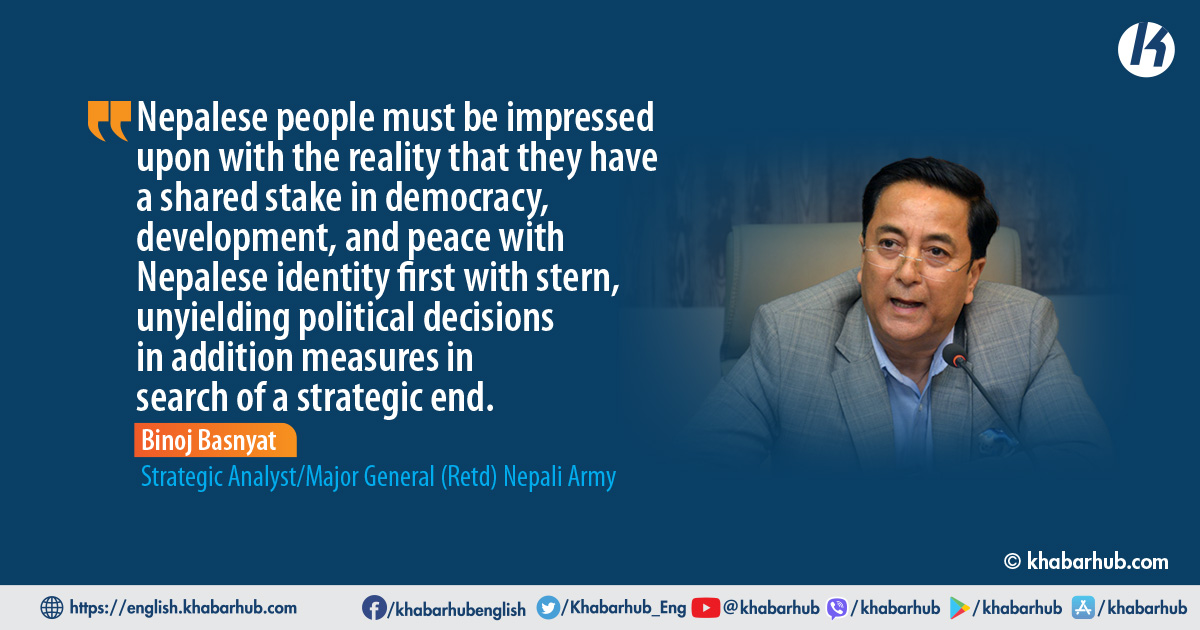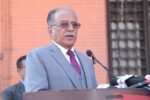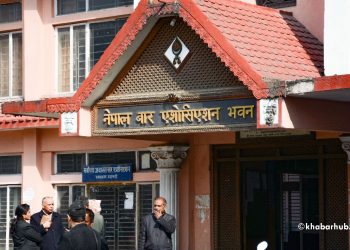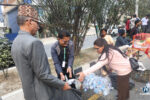Nepal’s destiny, “Khusi Nepali and Sambriddha Nepal” (Happy Nepali and Prosperous Nepal), was coined on 12 February 2018 during the Fireside Chat conducted by Kantipur TV.
The refrain took a national itinerary when then Prime Minister KP Oli revealed it on March the same year from Rara, Mugu District.
It pertains to national stability and national credibility. This is in momentous inconveniences that stride with unaccountable political governance.
This points out to four issues: the aspirational contradiction of the Nepal Communist Party Maoists Centre (NCPMC), the 12-point agreement sponsored by New Delhi, people’s participation in the change of the political system, and lastly, extensive politicization with institutionalization of corruption.
All these concerns enumerate Indian congress with support from the left-led government’s policy as well as a few western countries’ strategies to pave the way for controlled instability.
Strategies were guided for political influence through cultural divergence, marginalizing rich social and religious practices, which paved the way for political alteration rather than democratic realism.
Peaceful protest led by Durga Prasai in the streets of major cities of Nepal is not a machination but classical realism brought through a decade and a half of unaccountability to the political changes and non-response to governance behaviors nurturing apprehension of national credibility and national stability.
The Kathmandu-centric pro and anti-republican demonstration is related to Nepal’s political destiny.
The announcement of agitation by two groups: Communist Party of Nepal (United Marxist Leninist (CPN-UML) affiliated Yuva Sangh and medical entrepreneur Durga Prasai-led group with two diverse calls.
Unemployment is another problem contributing to the economic downturn, though remittances have remained a substantial part of the economy. 63.7 percent of the population is below the age of 30 years.
Prasai-led group is in favor of the elimination of the present-day republican system, while the Yuva Sangh called for the resignation of the Prachanda-led government, upholding support for the prevailing republican arrangement.
The agendas and the method of democratic expression with a functional ‘civil soldiers’ turn of mind have political-security and political-economy bearings.
The “causes” for the protest in reality do not quantify by presence in the street.
What were the impediments for the peaceful protest organized/led by Durga Prasai requires analysis?
Most important is the nation’s acceptance of political, governance, and economic misconduct in-house and national credibility externally.
Propositions of realism are state-centric: anarchy (no actor is above states), egoism (self-interest), and power politics.
The mainspring or the agitation is “classic realism” where national interests overshadow ideology.
NCPMC aspirational contradiction The ten-year people’s armed revolt against democratic practice did not result in the basic aim of the NCPMC, which was to capture state power and establish a “new people’s democracy.”
Inherited from the thoughts of Mao Zedong, which in turn built on the views of Lenin, Trotsky, and Stalin, did not come out with a clear end.
The House of Representatives holds 32 parliamentarians, making it the third-largest party from first in the parliament with an indication of less attendance in the upcoming election.
The party has led three previous governments in 2008, 2013, and 2016. The members in the house were larger when the Maoists Centre allied in the election with both the Nepali Congress and the CPN-UML.
The Maoists are the orchestrator of the alteration in the political system of Nepal into a republic, federal, secular, and inclusive, and the Premiership of Socialist Front is wedged with NCPMC interests and agendas than national issues both in international and national forums.
The waning of military capabilities by the state, the geopolitical environment, and political-diplomatic pressure were a hold-up to the “new democratic revolution” that passes through from the classical Marxist stages of bourgeois hegemony or the “old democracy” to proletarian hegemony or “new democracy” and entered the 12-point agreement.
With active participation in the democratic practice, it can be comprehended that the political treads are a combination with the Leninist theory of “continuous revolution” that has been the source of NCPMC vision of their scuffle.
This is similar to the strides of other democratic political forces questioning the armed revolt against a democratically elected government.
12-point agreement mediated by New Delhi There are two components piloting the Seven-Party Alliance and the Unified Communist party of Nepal Maoists 12-point agreement of 2005 in Delhi and subsequent mass movement of April 2006; domestic and external that transformed Nepal into a secular, federal democratic republic.
In India, it was the day-to-day government the Indian Congress supported by the left, fear of Maoists ideology and support spilling over in other Indian provinces and contradicting political behavior in Nepal.
India was backed up by international interests particularly about the social setups and Hinduism.
In Nepal, it was the fear of marginalization of the political forces, the weakening of the Maoists outfit, and the underestimation of international diplomacy implication by King Gyanendra the then Head of the State and Government.
As of 2011, five years down the roads, the exhilaration of April 2006 showed little progress leading to the current state of affairs doubting the change in the political governance system.
Political instability with factionalism has been a hindrance to resolve key political issues questioning the establishment of a stable democratic rule.
In opposition constitutional social engagements, anti-national identity activities, party-biased government policies, government performances, economic decline, international political trust, diplomatic disbelief, and people’s trust in the political forces have been signaling the failure of the political system.
People’s participation in the change of the political system
The declaration of the constitution on 20 September 2015 came amid two important factors.
One, protests by Madhesi and Tharu groups leaving 57 deaths. It also came without vibrant democratic process on the crucial strategic issues.
The reinstated parliament by King Gyanendra in 2007 adopted an interim constitution declaring the country secular, federal republic, and called for a constituent assembly to write the constitution within four years on 28 May 2010.
But then again, it took eight years of political internal strife that witnessed six governments fall and two constituent assemblies elected.
Critical matters of the change in the political system were ignored in the debate over the constitution and have been the fault lines in Nepali politics during the making of the constitution that took almost a decade.
Extensive politicization, lack of strategic thought and planning with institutionalization of corruption:
The past three decades have witnessed political changes, including the decade-long armed struggle and seven constitutions in the last 70 years.
Political instability, corruption, unemployment, low investment, poverty, unskilled workforce, politicized and weak institutions, dependence on remittances, trade barriers, natural disasters, lack of access to finance, limited resources mobilization, income inequality, and poverty are challenges that limit potentials for economic growth and reduce poverty.
The latest, promulgated on 20th September 2015, has been ineffective and may be short-lived.
After the republican setup as of 2008, the country has seen 10 governments, raising questions about political stability.
Unemployment is another problem contributing to the economic downturn, though remittances have remained a substantial part of the economy. 63.7 percent of the population is below the age of 30 years.
The International Labour Organisation rates Nepali youths aged 15-29 at 19.2 percent, compared to 2.7 percent for the whole population.
Over 400,000 young people are estimated to enter the labor force every year.
Unemployment and a high inflation rate are forcing many young Nepalis to seek jobs in other countries, which is around the age of 25-35.
In the FY2021-22, an average of 1,745 people left Nepal every day to seek employment abroad.
It is estimated that the number will increase to 2,546 persons leaving Nepal each day in the current fiscal year.
The Department of Foreign Employment has approved labor migration to 110 countries; there are estimates that Nepalese migrate to 170 countries using different and unwanted routes and agents.
One of three households receives remittances, accounting for 10 percent of GDP in 1999, which has grown significantly in the last two decades during the conflict, along with the peace process and post-conflict.
Remittance remains a crucial pillar of the economy. Nepal received remittances worth NPR 875 billion, constituting 23.3 percent of the GDP during 2019/20 and 24.25 percent in 2020/21, almost one-third of the national budget.
Foreign aid accounts for more than half of the development budget. Tourism and the service sector are important parts of employment and the GDP.
The World Bank estimates 4.9 percent growth in FY2024, lower than the 5.1 percent in FY2023.
The fiscal deficit is projected to fall from 3.4 percent of gross domestic product (GDP) in FY2023 to 2.4 percent in FY2024.
While institutionalization of corruption, inefficient deliveries, politicization of institutions, unprofessional bureaucracy, and political unaccountability are the sources of the complexities in the national economy and citizenry irritations.
Inflation hit 12 percent according to Nepal Rastra Bank, largely driven by high prices of food and fuel, making normal life difficult.
Political instability, corruption, unemployment, low investment, poverty, unskilled workforce, politicized and weak institutions, dependence on remittances, trade barriers, natural disasters, lack of access to finance, limited resources mobilization, income inequality, and poverty are challenges that limit potentials for economic growth and reduce poverty.
Foreign Policy is also in brink as political parties attempt to balance with its two immediate neighbors, China and India.
National Foreign Policy seems less significant due to a pro-India and pro-China tilt.
The US is also a significant actor in managing foreign policy.
The government is very reluctant to address environmental concerns projected by the World Bank and the Asian Development Bank, with Nepal being on the Climate Risk Country Profile by 2030.
Around 199,000 Nepalese may be affected by floods and droughts, with the annual impacts of floods on the country’s GDP estimated to be around US$574 million.
The risk to national security through non-traditional means is ongoing from identity politics raised by ethnic and regional groups, non-compliance with law and order leading to an increase in violence, rise in crime, extremism, hub of narcotics, human trafficking, and above all, criminalization of politics, institutionalization of corruption, and politicization of government machinery.
Conclusion
The new political forces, mainly NCPMC and Madhesh based political parties, after the Comprehensive Peace Agreement, are being questioned.
The main two national parties, the NC and UML, are less dependable. Trust is being lost from both the Nepalese populations and the international community, when the nation is losing time with trapped prospects.
The economy is vital for making political decisions; therefore, foreign aid and economic benefits of migration are not the answers to the multi-layered, multi-dimensional, and multifaceted intricacies.
Three issues are on the streets of Kathmandu, all related to the constitutional provisions: the political system with federation, national identity, and inefficient and corrupt government machinery.
Nepalese people must be impressed upon with the reality that they have a shared stake in democracy, development, and peace with Nepalese identity first with stern, unyielding political decisions in addition measures in search of a strategic end.
But the common annoyance among the people is the change of the political system to a federal republic and secularism with an absence of a strategic end.
While institutionalization of corruption, inefficient deliveries, politicization of institutions, unprofessional bureaucracy, and political unaccountability are the sources of the complexities in the national economy and citizenry irritations.
Proceedings are leading the country to volatility, uncertainty, complexity, and ambiguity. National credibility is being questioned.
Two national courses of action with the “doctrine of necessity” are observant. One is the marginalization of the main three political forces: the NC, UML, and the NCPMC with the rise of new political forces.
Two, political consensus to put an end to anarchical ways of governance with an amendment in the constitution with ‘legal maxim’ or ‘extra-legal actions’ advanced by more medieval jurist Henry de Bracton and recent legal authorities, including Sir William Blackstone.
The 1954 Pakistani Chief Justice Muhammad Munir validated the extra-constitutional use of emergency powers by Governor-General Ghulam Mohammad in which the Chief Justice cited Bracton’s maxim, ‘that which is otherwise not lawful is made lawful by necessity.’
The supreme court in Canada utilized the doctrine of necessity in 1988 ‘Reference re Remuneration of Judges (No2)’ submitting the necessity of a judge with an acceptable uneasiness on bias continuing to decide a matter if there is no alternative to that judge.
Nepalese people must be impressed upon with the reality that they have a shared stake in democracy, development, and peace with Nepalese identity first with stern, unyielding political decisions in addition measures in search of a strategic end.
(Binoj Basnyat is a Strategic Analyst, Major General (Retd) of the Nepali Army, and is associated with Rangsit University, Thailand)









Comment